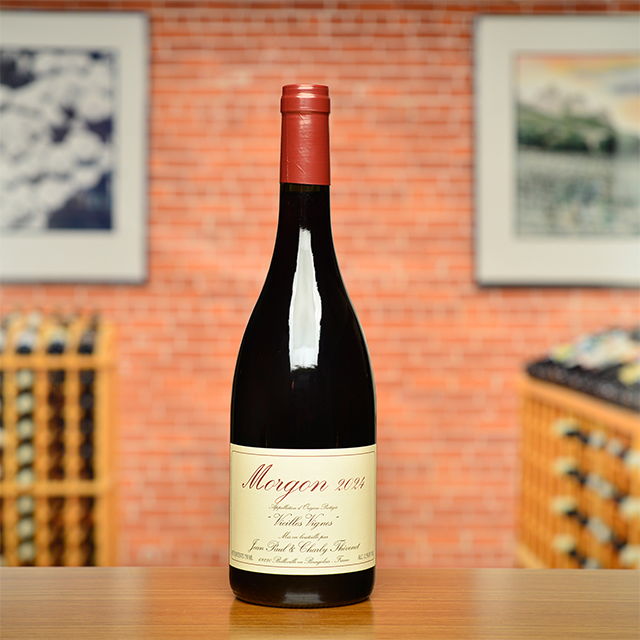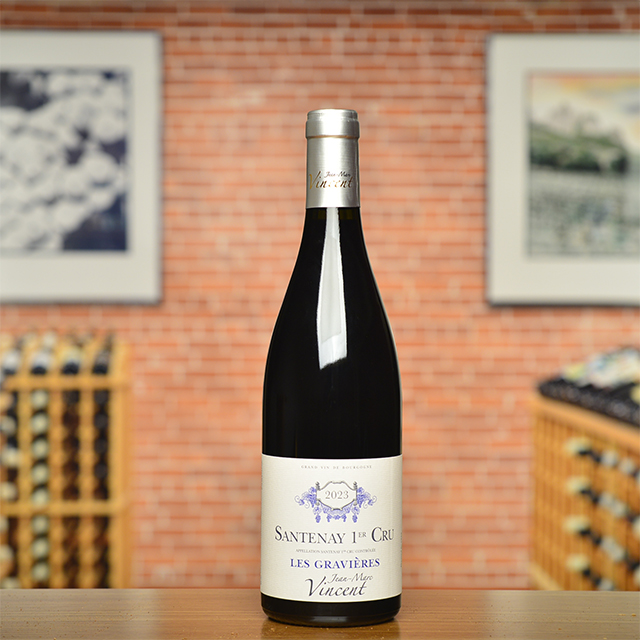Notify me
2020 Morgon “Vieilles Vignes”
Jean-Paul et Charly Thévenet
Charly Thévenet and his father, Jean Paul, now bottle a range of five different wines in their cellars in Villié-Morgon, although this old-vine Morgon bottling —for many years the only wine the family produced—still rules the roost. If Beaujolais were Burgundy (thank goodness it isn’t!), we might consider Morgon to be Vosne-Romanée, with its haunting perfume and silky texture, the proverbial iron fist in a velvet glove.
—Dixon Brooke
| Wine Type: | red |
| Vintage: | 2020 |
| Bottle Size: | 750mL |
| Blend: | Gamay |
| Appellation: | Morgon |
| Country: | France |
| Region: | Beaujolais |
| Producer: | Jean-Paul et Charly Thévenet |
| Winemaker: | Jean-Paul et Charly Thévenet |
| Vineyard: | 70 years, 4.85 ha |
| Soil: | Decomposed Granite, Sand |
| Aging: | Wines aged on fine lees in 5-7 year-old oak Burgundian barrels for 6-8 months |
| Farming: | Biodynamic (practicing) |
| Alcohol: | 13.5% |
More from this Producer or Region

2024 Brouilly “Reverdon”
France | Beaujolais
This bottling is classic Brouilly, balanced and old-school, and showcases the beauty of Gamay.

2023 Moulin-à-Vent “Sous la Roche”
France | Beaujolais
It combines the structural grandeur typical of Moulin-à-Vent with a high-elevation freshness.

2021 Beaujolais Blanc “Terrain Rouge”
France | Beaujolais
Charly Thévenet and his father, Jean Paul, now bottle a range of five different wines in their cellars in Villié-Morgon

2024 Morgon “La Roche Pilée”
France | Beaujolais
October Club Gourmand ~ The newest addition to the Thévenets’ Morgons, La Roche Pilée is lush and light at the same time, with a balance of soft minerality referenced in the name (which means crushed rock).

2024 Régnié “Grain & Granit”
France | Beaujolais
Here is a rich, bold Régnié, saturated with luscious fruit and earthy spice.

2022 Régnié
France | Beaujolais
Savor it while you can, because your glass will be empty before you know it, leaving you only with the spicy, mineral-laden aftertaste of a bottle that went down way too easily.

2023 Beaujolais-Villages
France | Beaujolais
November Club Chevalier ~ Silky and seductive, with notes of rose petals, red berries, and stones.

2024 Morgon “Vieilles Vignes”
France | Beaujolais
If Beaujolais were Burgundy, we might consider Morgon to be Vosne-Romanée, with its haunting perfume and silky texture, the proverbial iron fist in a velvet glove.

2024 Vin de France Rouge “Raisins Gaulois”
France | Beaujolais
This juicy red—brimming with bright, playful fruit—is low in alcohol and delightfully refreshing.

2023 Chénas “Les Blémonts”
France | Beaujolais
Structured yet full of energy, with notes of blueberry, spice, and other things nice.
About The Producer
Jean-Paul et Charly Thévenet
Jean-Paul Thévenet is the third generation to produce wine at his family estate in Morgon, but as a young man he took the domaine in an unexpected direction. In the early 1980s Beaujolais was flooded with commercialized wine, pushing winemaker and viticultural prophet Jules Chauvet to invoke a return to more traditional practices. Jean-Paul and three other local vignerons, Marcel Lapierre, Guy Breton, and Jean Foillard, soon took up the torch of this “natural wine” movement.
Known as “Paul-Po” among friends, Jean-Paul is reserved yet fun-loving. He farms his small five-hectare domaine with his son, Charly, and since 2008 the two have taken the domaine to the next level by adopting organic and biodynamic viticultural practices.
About The Region
Beaujolais

After years of the region’s reputation being co-opted by mass-produced Beaujolais Nouveau and the prevalence of industrial farming, the fortunes of vignerons from the Beaujolais have been on the rise in the past couple of decades. Much of this change is due to Jules Chauvet, a prominent Beaujolais producer who Kermit worked with in the 1980s and arguably the father of the natural wine movement, who advocated not using herbicides or pesticides in vineyards, not chaptalizing, fermenting with ambient yeasts, and vinifying without SO2. Chief among Chauvet’s followers was Marcel Lapierre and his three friends, Jean Foillard, Guy Breton, and Jean-Paul Thévenet—a group of Morgon producers who Kermit dubbed “the Gang of Four.” The espousal of Chauvet’s methods led to a dramatic change in quality of wines from Beaujolais and with that an increased interest and appreciation for the AOC crus, Villages, and regular Beaujolais bottlings.
The crus of Beaujolais are interpreted through the Gamay grape and each illuminate the variety of great terroirs available in the region. Distinguishing itself from the clay and limestone of Burgundy, Beaujolais soils are predominantly decomposed granite, with pockets of blue volcanic rock. The primary vinification method is carbonic maceration, where grapes are not crushed, but instead whole clusters are placed in a tank, thus allowing fermentation to take place inside each grape berry.
Much like the easy-going and friendly nature of many Beaujolais vignerons, the wines too have a lively and easy-drinking spirit. They are versatile at table but make particularly good matches with the local pork sausages and charcuterie. Though often considered a wine that must be drunk young, many of the top crus offer great aging potential.
More from Beaujolais or France
2024 Régnié “Grain & Granit”
Jean Paul et Charly Thévenet France | Beaujolais
2024 Beaujolais
Domaine Dupeuble France | Beaujolais
2023 Chénas “Vibrations”
Domaine Thillardon France | Beaujolais
2024 Fleurie
Guy Breton France | Beaujolais
2024 Beaujolais-Villages “Cuvée Marylou”
Guy Breton France | Beaujolais
2024 Beaujolais-Villages “Cuvée Marylou” MAGNUM
Guy Breton France | Beaujolais
2022 Régnié
Guy Breton France | Beaujolais
2023 Côte de Brouilly
Château Thivin France | Beaujolais
2024 Beaujolais MAGNUM
Domaine Dupeuble France | Beaujolais
2023 Chénas “Chassignol”
Domaine Thillardon France | Beaujolais
2024 Vin de France Rouge “Raisins Gaulois”
M. & C. Lapierre France | Beaujolais
2025 Beaujolais Nouveau
La Sœur Cadette France | Beaujolais
2024 Régnié “Grain & Granit”
Jean Paul et Charly Thévenet France | Beaujolais
2024 Beaujolais
Domaine Dupeuble France | Beaujolais
2023 Chénas “Vibrations”
Domaine Thillardon France | Beaujolais
2024 Fleurie
Guy Breton France | Beaujolais
2024 Beaujolais-Villages “Cuvée Marylou”
Guy Breton France | Beaujolais
2024 Beaujolais-Villages “Cuvée Marylou” MAGNUM
Guy Breton France | Beaujolais
2022 Régnié
Guy Breton France | Beaujolais
2023 Côte de Brouilly
Château Thivin France | Beaujolais
2024 Beaujolais MAGNUM
Domaine Dupeuble France | Beaujolais
2023 Chénas “Chassignol”
Domaine Thillardon France | Beaujolais
2024 Vin de France Rouge “Raisins Gaulois”
M. & C. Lapierre France | Beaujolais
2025 Beaujolais Nouveau
La Sœur Cadette France | Beaujolais
Kermit once said...

Kermit once said...
I want you to realize once and for all: Even the winemaker does not know what aging is going to do to a new vintage; Robert Parker does not know; I do not know. We all make educated (hopefully) guesses about what the future will bring, but guesses they are. And one of the pleasures of a wine cellar is the opportunity it provides for you to witness the evolution of your various selections. Living wines have ups and downs just as people do, periods of glory and dog days, too. If wine did not remind me of real life, I would not care about it so much.
Inspiring Thirst, page 171
















